Chery Tiggo 7
The Chery Tiggo 7 is a compact crossover produced by Chery under the Tiggo product series. The first generation was launched in 2016, and a rebadged variant sold by Qoros was planned in 2017 which later became a facelift for the 2018 model year Tiggo 7 dubbed the Tiggo 7 Fly. The first generation Tiggo 7 also underpins the Exeed LX. The second generation model was launched in 2020 and was previewed by a design concept unveiled in 2019.
| Chery Tiggo 7 | |
|---|---|
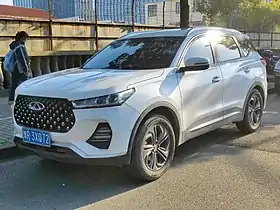 Second generation Chery Tiggo 7 | |
| Overview | |
| Manufacturer | Chery |
| Also called |
|
| Production | 2016–present |
| Body and chassis | |
| Class | Compact crossover SUV |
| Layout | |
First generation (2016–2019)
| Chery Tiggo 7 | |
|---|---|
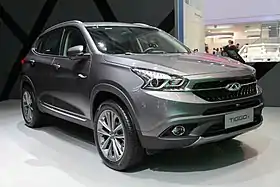 Chery Tiggo 7 | |
| Overview | |
| Manufacturer | Chery |
| Also called | Chery T15[1] Qoros Young DR F35 |
| Production | 2016 – 2019 |
| Assembly | Wuhu, Anhui, China Anápolis, Brazil |
| Designer | James Hope |
| Body and chassis | |
| Class | Compact crossover |
| Body style | 5-door station wagon |
| Layout | Front-engine, front-wheel-drive or four-wheel-drive |
| Platform | T1X |
| Related | Chery Tiggo 8 Exeed LX |
| Powertrain | |
| Engine | 1.5 L SQRE4T15 I4 (gasoline) turbo 2.0 L SQR484F I4 (gasoline)[2] |
| Transmission | 6-speed manual 6-speed DCT CVT |
| Dimensions | |
| Wheelbase | 2,670 mm (105.1 in) |
| Length | 4,505 mm (177.4 in) |
| Width | 1,837 mm (72.3 in) |
| Height | 1,670 mm (65.7 in) |

The first generation Chery Tiggo 7 was originally previewed by the Chery TX SUV Concept during the 2012 Beijing Auto Show,[3][4] the production version was revealed during the 2016 Beijing Auto Show in China.[5]
Engine options available initially includes a 1.5 liter inline-four turbo petrol engine and a 2.0 liter inline-four petrol engine.
The production Chery Tiggo 7 was later launched on the China car market in July with prices starting from 85,900 yuan to 150,900 yuan, positioning the Chery Tiggo 7 above the Chery Tiggo 5 compact crossover.[6]
2018 facelift and Qoros Young rebadge
In August 2017, the Qoros Young compact crossover was revealed as a rebadged version of the Chery Tiggo 7. Chery owns half of the Qoros holding while the other half belongs to Singapore-based investment company Kenon Holdings.[7] The Qoros Young never launched on the market, with its design instead reused as the facelifted Chery Tiggo 7 Fly revealed in 2018.
The Tiggo 7 Fly debuted in September 2018 with prices starting from 85,900 yuan to 113,900 yuan. The facelift model continue to use the same powertrain as the pre-facelift model, a 1.5 liter turbo producing 147hp and 210N·m. The transmission is a 6-speed dual-clutch transmission or a 6-speed manual gearbox.[8]
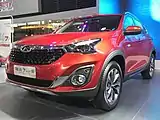 Chery Tiggo 7 Fly (2018 facelift) front
Chery Tiggo 7 Fly (2018 facelift) front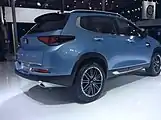 Qoros Young rear
Qoros Young rear
Second generation (2020–present)
| Chery Tiggo 7 II | |
|---|---|
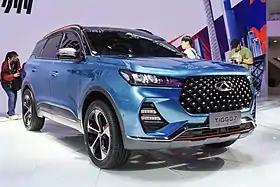 | |
| Overview | |
| Manufacturer | Chery |
| Also called | Chery Tiggo 7 Plus Chery Tiggo 7 Pro DR 6.0 (Europe) Fownix Tiggo 7 Pro (Iran) |
| Production | 2020 – present |
| Assembly | Wuhu, Anhui, China Anápolis, Brazil Bekasi, Indonesia |
| Body and chassis | |
| Class | Compact crossover |
| Body style | 5-door station wagon |
| Layout | Front-engine, front-wheel-drive |
| Related | Chery Tiggo 8 Exeed LX |
| Powertrain | |
| Engine | 1.5 L SQRE4T15C I4 (gasoline) turbo 1.6 L SQRF4J16 I4 (gasoline) turbo |
| Transmission | 6-speed manual 7-speed DCT 9-speed CVT |
| Dimensions | |
| Wheelbase | 2,670 mm (105.1 in) |
| Length | 4,500 mm (177.2 in)[9] |
| Width | 1,842 mm (72.5 in) |
| Height | 1,746 mm (68.7 in) |
| Curb weight | 1,465 kg (3,230 lb) |
The second generation Chery Tiggo 7 debuted as a concept during the 2019 Guangzhou Auto Show,[10] Engine options of the second generation Chery Tiggo 7 initially includes a 1.5 liter inline-four turbo petrol engine producing 147 hp, 1.5 liter inline-four turbo petrol engine producing 156 hp and a 1.6 liter inline-four petrol engine producing 197 hp.[11]
 Second generation Tiggo 7 (front)
Second generation Tiggo 7 (front) Second generation Tiggo 7 (rear)
Second generation Tiggo 7 (rear)
Tiggo 7 Plus
The Tiggo 7 Plus is a more premium variant of the regular Tiggo 7, aiming at a slightly higher market segment. The Tiggo 7 Plus features a restyled front bumper and grilles and slightly improved interior. The infotainment system of the Tiggo 7 Plus comes with Baidu CarLife and Apple CarPlay and runs on Chery’s Lion 4.0 operating system.[12]
The Tiggo 7 Plus is available with three powertrains including a 1.5 liter turbo engine with 156 hp and 230 Nm, mated to a 6-speed manual transmission and CVT, a 1.5 liter turbo engine plus 48V with 156 hp and 230 Nm, mated to a CVT, and a 1.6 liter turbo engine with 197 hp and 290 Nm, mated to a 7-speed DCT. The 1.5 liter turbo engine consumes 6.9 liters per 100 km while the 1.5 liter turbo engine plus 48V consumes 5.9 liters per 100 km. The 1.6 liter turbo engine variant consumes 6.6 liters per 100 km.[12]
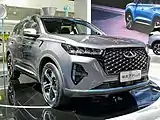 Tiggo 7 Plus (front)
Tiggo 7 Plus (front) Tiggo 7 Plus (rear)
Tiggo 7 Plus (rear)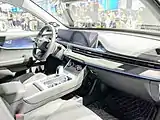 Tiggo 7 Plus (interior)
Tiggo 7 Plus (interior)
References
- "First images of the new Chery Tiggo 7 SUV for China".
- "Chery TX SUV to see production in China".
- "Chery to bring 'TX' SUV concept to the Beijing Auto Show".
- "Official Pics: Chery TX SUV concept for the Beijing Auto Show".
- "Chery Tiggo 7 debuts on the Beijing Auto Show".
- "This Is The Chery Tiggo 7 SUV For China".
- "Qoros Young Compact SUV Revealed In China Is Not For The Elderly".
- "售8.59-11.39万元 瑞虎7 FLY正式上市".
- "2020 Chery Tiggo 7 specs".
- "2019广州车展:奇瑞新瑞虎7量产概念车".
- "2020 Chery Tiggo 7 specs".
- "Chery Tiggo 7 Plus Launched On The Chinese Car Market".